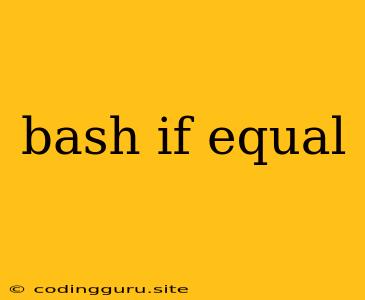Bash if Equal: A Guide to Conditional Statements in Bash
Bash, the Bourne Again Shell, is a powerful command-line interpreter used on various Unix-like systems. One of its core functionalities lies in its ability to execute commands based on specific conditions. This is achieved through conditional statements, where the script's flow is altered depending on the outcome of a test. Among these conditions, checking for equality is a fundamental operation often employed in scripting.
This article aims to guide you through the intricacies of using the "if equal" statement in bash scripting, empowering you to write scripts that can dynamically respond to different input scenarios.
The Fundamentals of Bash if Statements
The cornerstone of conditional logic in bash lies within the if statement. It operates on a simple premise: evaluate a condition, execute a block of commands if the condition is true, and optionally execute another block if the condition is false.
The general syntax for an if statement is:
if [ condition ]; then
# Commands to execute if the condition is true
fi
The [ ] brackets denote a test command. Here, condition refers to the expression that is evaluated. If the evaluation results in a "true" value, the commands within the then block are executed. If not, the script continues without executing the then block.
Testing for Equality in Bash
Bash provides various operators to test different conditions, and one of the most common is the equality operator. This operator determines whether two values are identical. In bash, there are two ways to check for equality:
-
Using the
-eqoperator:This operator is specifically designed for numerical comparisons. For example:
if [ $variable -eq 10 ]; then echo "The variable is equal to 10" fiThis snippet checks if the variable
$variableholds the value 10. If so, the message is displayed. -
Using the
==operator:This operator is used for string comparisons. Here's how you would compare strings:
if [ "$string1" == "$string2" ]; then echo "The strings are equal" fiIn this case, the code compares the contents of the variables
$string1and$string2. If the strings match, the message is printed.
Important Considerations
- Spaces are Crucial: Remember that spacing matters within the
ifstatement. Leave spaces around the[ ]brackets and around the operator (-eqor==). - Quoting for String Comparisons: Always use double quotes around string variables to prevent potential issues with spaces or special characters.
- Case Sensitivity: Bash string comparisons are case-sensitive. "Hello" is not equal to "hello".
Example Use Cases
Let's illustrate the practical applications of the if equal statement with some examples:
1. Checking User Input:
read -p "Enter a number: " num
if [ $num -eq 5 ]; then
echo "You entered the number 5!"
else
echo "You entered a different number."
fi
This script prompts the user for input. If the user enters the number 5, the script prints a corresponding message. Otherwise, it displays a different message.
2. Comparing File Sizes:
file1="file1.txt"
file2="file2.txt"
if [ $(stat -c%s $file1) -eq $(stat -c%s $file2) ]; then
echo "The files have the same size"
else
echo "The files have different sizes"
fi
This script compares the sizes of two files. The stat command with the %s option is used to retrieve the file size in bytes. If the sizes are identical, the message "The files have the same size" is printed; otherwise, "The files have different sizes" is displayed.
3. Validating User Credentials:
read -p "Enter username: " username
read -p "Enter password: " -s password
if [ "$username" == "admin" ] && [ "$password" == "secret" ]; then
echo "Login successful!"
else
echo "Invalid username or password."
fi
This script prompts for a username and password. The script checks if the entered credentials match the predefined values. If they do, it prints a success message; otherwise, it indicates an invalid login attempt.
Beyond the Basics
For more complex scenarios, bash offers additional features that build upon the foundation of the if equal statement.
-
elif (Else If): This keyword allows you to check multiple conditions sequentially. For example:
if [ $number -lt 0 ]; then echo "The number is negative." elif [ $number -eq 0 ]; then echo "The number is zero." else echo "The number is positive." fi -
Nested if Statements: You can embed
ifstatements within otherifstatements to create multi-level logic. -
Logical Operators: The
&&(AND) and||(OR) operators can be used to combine multiple conditions within a singleifstatement.
Conclusion
The if equal statement is a fundamental building block for writing dynamic and flexible bash scripts. By mastering the syntax and applying it to different scenarios, you gain control over your script's flow, enabling it to respond to diverse inputs and conditions. From simple comparisons to complex decision-making, the if equal statement empowers you to craft robust and adaptable bash scripts.
